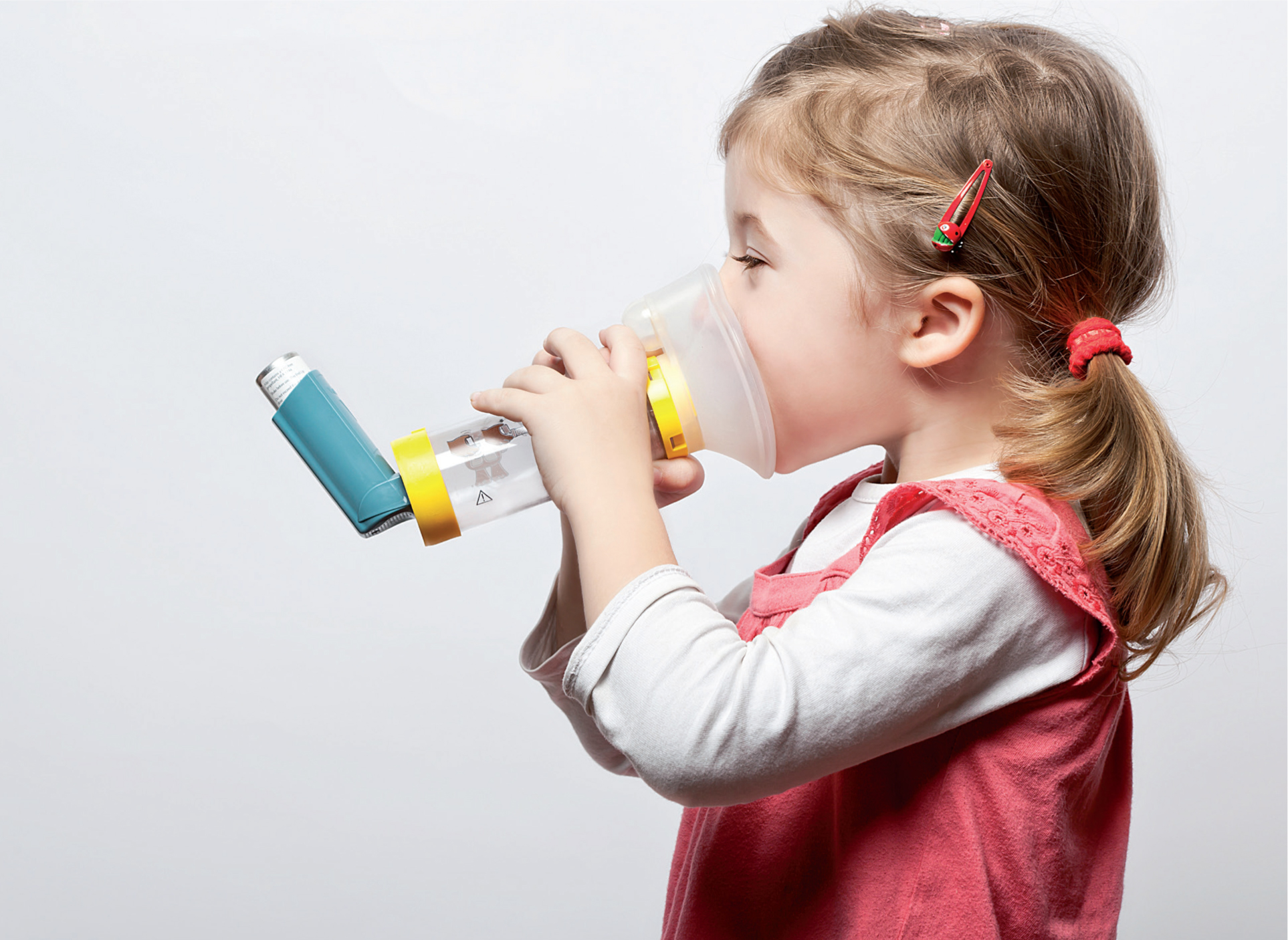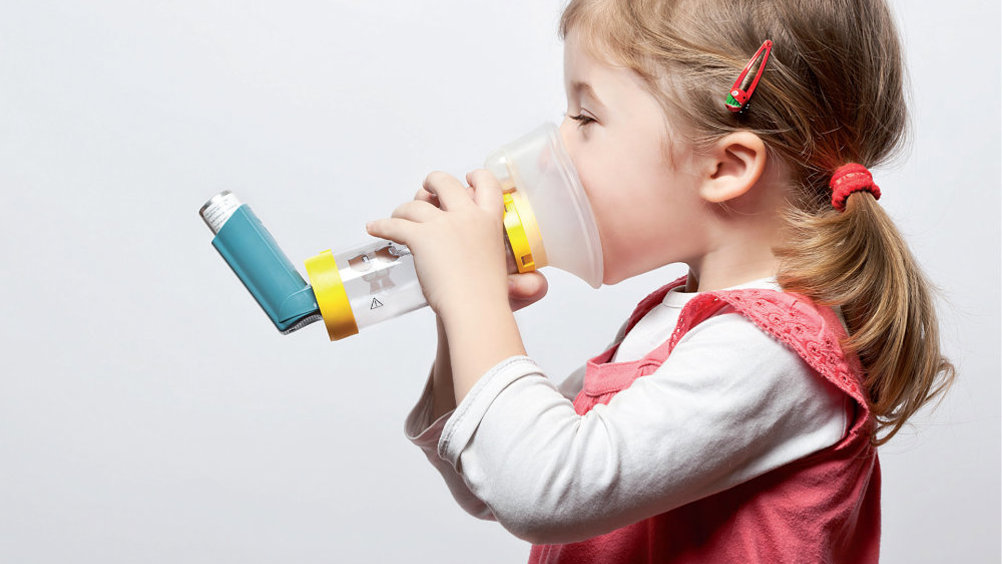Tip 1: Always prescribe a spacer with a metered dose inhaler
The purpose of the spacer device is to act as an intermediary chamber into which a pressurised metered dose inhaler (pMDI) can discharge the drug. This slows down the drug, which is propelled at force as an aerosol, allowing evaporation. This increases the respirable particle fraction leading to better lung deposition (National Institute for Health and Care Excellence (NICE), 2000). For this reason, a pMDI should always be used with a spacer device in young children and is recommended in adults who may have poor manual dexterity and/or learning difficulties (Vincken et al, 2018).
Using a metered dose inhaler without a spacer is difficult. All metered dose inhaler systems (MDI) require co-ordination of activation and inhalation and may be difficult to use, particularly for younger children. In addition, inhaler technique by many health professionals, who may be teaching technique to parents and children, is poor. In a questionnaire of health professionals in Ghana, only nine of the 75 (12%) participants, all of whom were doctors, knew at least three essential steps of the techniques in using a pMDI correctly. None of the participants got all the steps totally correct (Adeniyi et al, 2018).
Tip 2: Choose a spacer with a valve
There are two types of devices:
- Spacers – an additional reservoir between the mouthpiece of the pMDI and the patient's mouth
- Valve holding chambers (VHCs), which also have a one-way valve.
A spacer simply creates a greater distance between the inhaler and the mouth, whereas the valve in a VHC enables the retention of the aerosol inside the device until the child breathes it in from the device, and cannot breathe back into it.
Tip 3: ‘Sell’ the benefits to parents and children to improve concordance with treatment
Poor adherence and poor technique should always be considered when there is a failure to control asthma symptoms. It is estimated that between a third and a half of all medicines prescribed for long-term conditions are not taken as recommended (Vincken et al, 2018).
Spacers are bulky to carry around, although some collapse to a smaller size, while others can act as storage for a pMDI. However, children can forget to carry it around. Families often manage this by keeping devices in several places, such as two homes when parents share custody of the child.
As children get older they may start to feel stigma with using such big devices in front of peers. Therefore, it is useful to ‘sell’ the importance of introducing of a spacer with the following:
- Better control using smaller dosage – even with optimal technique, pMDIs alone will deliver only 20% of the drug to the lower airways, leaving 80% in the oropharynx (Vincken et al, 2018)
- Fewer side effects, both local (hoarseness and oral thrush due to deposition of corticosteroid particles) and systemic (β-adrenergic effects such as tachycardia due to gastrointestinal absorption)
- In emergencies, a VHC works as well as a nebuliser (Cates et al, 2013).
Nurses should still encourage mouth-rinsing and gargling to avoid oral thrush and hoarseness from inhaled corticosteroids, even though deposition in the oropharynx is reduced. Rashes on the face can be avoided by wiping the skin after using a mask.

Tip 4: Choose the best device for the patient
Not all spacers are equal, and performance may vary according to their size/volume, shape, material of manufacture and propensity to become electrostatically charged, their mode of interface with the patient, and the presence or otherwise of valves and feedback devices.
Small volume spacers are normally 100 ml or less. They do not usually have valves and their small size means more co-ordination is needed between actuation of the pMDI and inhalation. Particle clouds are more turbulent in smaller devices meaning that children may inhale most of the drug in the first breath. The advantage of a small device is its portability. Medium-volume (100–350 mL) and large-volume (>700 mL) spacers usually have a unidirectional valve at their mouthpiece end, allowing inhalation from, but not exhalation into, the spacer. In large-volume spacers the particle cloud becomes static prior to inhalation, providing evenly distributed delivery of the aerosol throughout the inhalation. As smaller children take smaller breaths, the larger the device the more time it takes to ‘empty’ the device.
Check that the mouthpiece of the pMDI is compatible with the inlet size and shape of the spacer. Many spacers have rubber inlets to accommodate different inhaler sizes and shapes. When using slightly mismatched devices ensure there are no gaps in the seal between the pMDI and the spacer and check that the inhaler fires towards the centre of the spacer.
Young children or older children with disabilities who cannot hold a mouthpiece between their teeth and make a seal with their lips will need a facemask. Choose a close fitting, comfortable mask that makes a good seal around the nose and mouth. Remember to review the size of the mask as the child grows.
Tip 5: Facilitate patient choice
Keep a range of devices in your clinic room. Show them to the child and carer, and demonstrate their use. The most important consideration for choosing a spacer is for the child and carer to select one that they will actually use, rather than perhaps the most clinically effective one (the one that the nurse would choose!).
Tip 6: Demonstrate and check technique at every appointment
There are two main inhaler techniques to use with spacers:
- Single breath and hold
- Tidal breathing.
The recommended technique is as follows (Vincken et al, 2018):
- Sit or stand up straight with the chin up and the neck slightly extended
- Shake the pMDI five times and remove its cap
- If using a valved spacer, shake it to check that the valve(s) is not stuck
- Hold the pMDI upright (with the canister up) and fit it into the spacer/VHC. Hold the pMDI–spacer/VHC assembly horizontal, with one hand holding the pMDI between the index finger and thumb, and the other hand supporting the mouthpiece end of the spacer/VHC
- Breathe out as far as is comfortable
- Place the spacer/VHC mouthpiece between the teeth and seal the lips around it (or place the mask gently but tightly over the nose and lips)
- Breathe in slowly, press the inhaler once and continue to breathe in slowly (over 4–5 seconds) until lungs are full
- Hold the breath for 10 seconds or for as long as is comfortable. While breath holding, take the spacer/VHC out of the mouth (or lower the mask) and relax
- When further doses are required, the entire sequence must be repeated for each additional dose, including shaking the pMDI if necessary. Multiple doses should never be fired together into the spacer/VHC and be inhaled with a single breath
- When the session is ended, take the pMDI out of the spacer/VHC port, place the cap back on the pMDI, and rinse the mouth and gargle after inhalation of a corticosteroid.
For younger children who cannot breath-hold, tidal breathing is recommended, whereby after pMDI activation, the child immediately breathes in and out normally for five breaths. Some studies suggest that this technique is equally effective (Stephen et al, 2015), while others suggest that it is inferior (Roller et al, 2007).
There are a number of websites with explanatory videos demonstrating correct inhaler and spacer technique, such as Asthma UK (www.asthma.org.uk), and various medical device manufacturers such as Trudell UK Ltd who demonstrate particular devices (www.trudellmed.com/instructions-use).
Using multiple actuations at the same time creates turbulence which decreases the respirable fraction of the aerosol, so always demonstrate technique showing single actuations with 30 seconds to 1 minute in between each actuation to avoid this issue (Rau et al, 1996). Some spacers incorporate a whistle that sounds when the patient is breathing in too forcefully. At least one spacer, however, makes a whistle to indicate that there is enough inspiratory effort in small children. Therefore, it is important to distinguish one from the other and to teach the child and/or carer what to listen for.
Tip 7: Explain how to care for the spacer to avoid static
While you probably do not have time during a consultation to talk in detail about this, it is important that you ask the child and carers to read the information leaflet and follow the right instructions to care for their device.
Spacers and VHCs made of non-conducting plastic materials create an electrostatic charge, which may result in inconsistent drug delivery (Suggett et al, 2015). The care instructions for such devices may talk about ‘priming’ the spacer, which often means washing the device before use in detergent and water and drip drying, as drying with a cloth can create an electrostatic charge.
Others may include instructions to repeatedly actuate the pMDI into the spacer before first use and after each wash. The theory here is that lubricants in the aerosol create an antistatic lining although real life evidence for this is unclear and wasteful of medication (Vincken et al, 2018). Other spacers and VHCs are designed to be antistatic and can be used straight out of the packet. Where the spacer is kept is also important and to avoid static should never be stored in a plastic bag. A large pencil case or bag, decorated and personalised by the child, may be an attractive option. Bacterial contamination of spacers and VHCs is common, so children and parents should be encouraged to wash their devices regularly according to manufacturer's instructions and never to share devices (Cohen et al, 2005).
Tip 8: Advise parents on supporting small children
Creating the right environment and mood is essential to make the administration of inhalers via spacers or VHCs as positive as possible.
Asthma UK (online) advises:
- If you have a baby or young toddler, sit them on your lap facing you so you can keep eye contact. With very young babies, you might find it best to tilt them back slightly
- Cuddle your baby on your knee or cradle them in your arms. Gently tuck their arms out of the way with one hand if they try to knock the mask away
- Be positive and smile! Your baby will be aware if you're anxious
- Gently stroke your baby's cheek with the mask so they get used to how it feels
- Reassure your child by pretending to take the medicine yourself or giving it to a favourite toy
- Distract your baby with music or a video if it helps.
Tip 9: Connect families to encourage self-help
Having a child with asthma can be stressful, and parents or carers may benefit from being supported by others in the same position. Many social media forums have no clinical moderation, which may lead to misinformation. Others may originate in other countries with different treatment regimens. Asthma UK has both a Facebook page and a WhatsApp service connected to a specialist nurse. Local asthma services sometimes set up Facebook pages to help people to connect. Your team may also want to set something up but be aware that moderation takes time. Alternatively, you may want to establish group consultations/shared medical appointments, where families can connect and share ideas.
Tip 10: Use the assets around you
Many schools, housing organisations and community groups (especially those supporting minority groups) and community pharmacies are extremely keen to support parents, carers and children with asthma. Connecting with these organisations and exchanging knowledge can be beneficial in extending local support to families.


